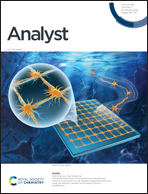MOF-derived porous ZnO-Co3O4 nanocages as peroxidase mimics for colorimetric detection of copper(ii) ions in serum†
Abstract
Sensitive detection of copper ions (Cu2+) in biological samples is extremely important since an abnormal level of Cu2+ is linked with many diseases. Herein, we demonstrated a novel turn-on colorimetric sensor for selective detection of Cu2+ both in buffered solution and serum samples based on porous bimetallic transition metal oxide nanocages (ZnO-Co3O4 NCs) as peroxidase mimics. The ZnO-Co3O4 NCs were prepared by using ZnCo-zeolitic-imidazolate-framework (ZnCo-ZIF) as precursors via direct calcination. With the high peroxidase-like activity, the obtained ZnO-Co3O4 NCs can catalyze the oxidation of tetramethylbenzidine (TMB) in the presence of H2O2 to form a blue colored product. The inhibition effect of cysteine (Cys) on the catalytic activity of ZnO-Co3O4 NCs and its strong binding ability toward Cu2+ enabled the ZnO-Co3O4 NCs/Cys system to be utilized for sensitive detection of Cu2+, in which the catalytic activity of ZnO-Co3O4 NCs/Cys can be recovered by the introduction of Cu2+ with an obvious color change of the solution. The linear range for Cu2+ determination was 2 to 100 nM with a detection limit of 1.08 nM. More importantly, this colorimetric sensor has been successfully applied to detect Cu2+ in serum without pretreatment. Our findings are expected to expand the scope of application of nanozyme and shed light on early disease diagnosis.



 Please wait while we load your content...
Please wait while we load your content...